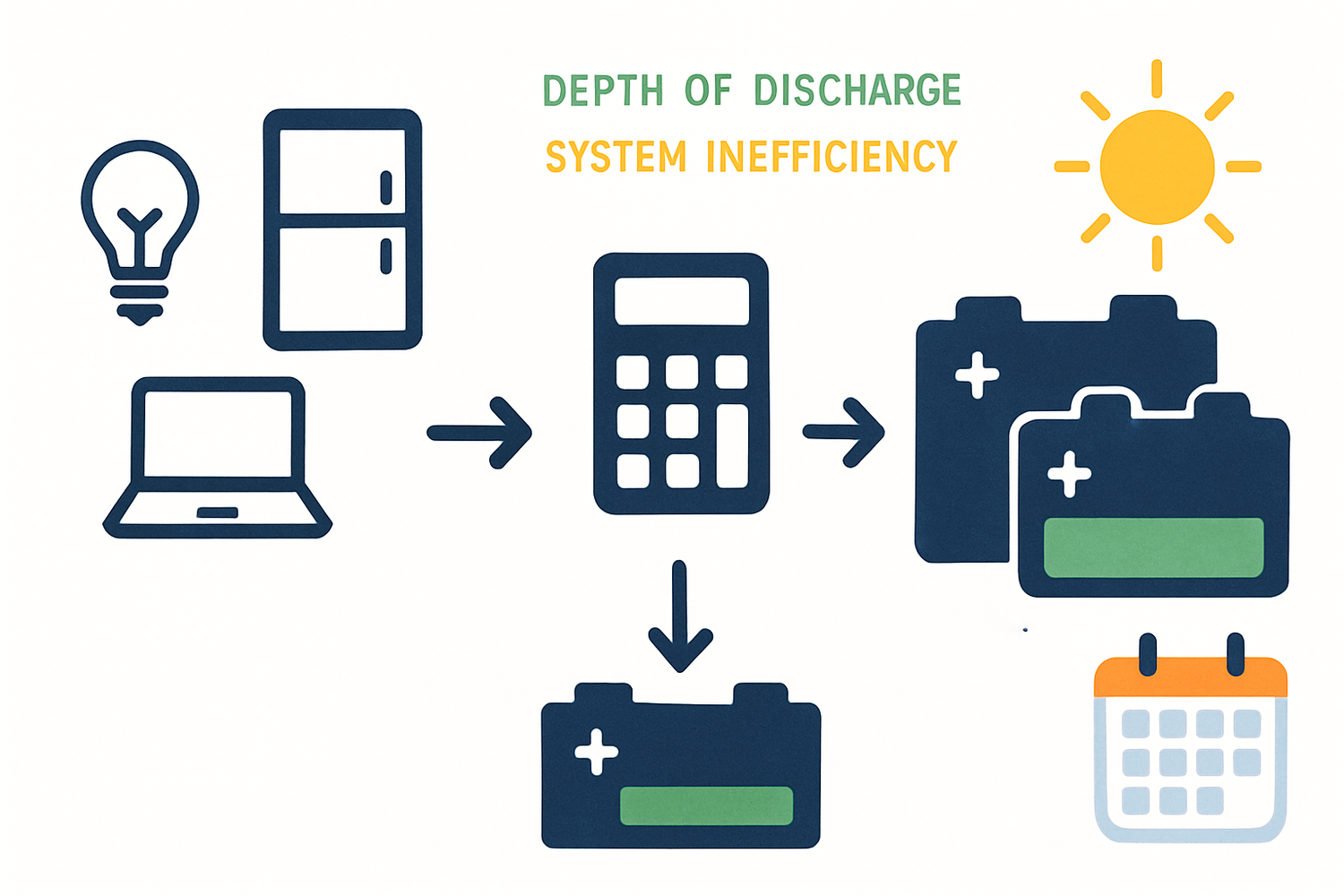Achieving energy independence with an off-grid solar system is a powerful goal. Yet, the success of any system hinges on one critical component: the battery bank. Incorrect sizing can lead to premature system failure, insufficient power when you need it most, and a wasted investment. This guide serves as a manual calculator, walking you through each essential variable to accurately perform your solar battery bank sizing and build a system you can depend on.
Step 1: Calculating Your Total Daily Energy Consumption (Watt-hours)
The first and most important step in sizing your off-grid solar battery bank is to determine exactly how much energy you use daily. The most accurate unit for this is the watt-hour (Wh). It provides a complete picture of energy use over time, unlike amp-hours, which can be misleading without the context of system voltage.
Creating a Comprehensive Load List
To begin, create a detailed list of every appliance and device that will run on your system. For each item, you need to find its power consumption in watts and estimate how many hours it will run per day. Multiplying these two numbers gives you the daily watt-hours for each device. Summing them all provides your total daily energy requirement.
| Appliance | Power (Watts) | Hours of Use per Day | Daily Energy (Watt-hours) |
|---|---|---|---|
| LED Lights (x5) | 10 W | 6 hours | 300 Wh |
| Refrigerator | 150 W (runs ~8 hrs/day) | 8 hours | 1200 Wh |
| Water Pump | 250 W | 1 hour | 250 Wh |
| Laptop Charger | 65 W | 4 hours | 260 Wh |
| Total Daily Consumption | 2010 Wh |
Factoring in Seasonal Variations
Your energy needs can change dramatically with the seasons. Winter often brings shorter days, reducing solar generation, while heating loads may increase. Conversely, summer might involve running fans or air conditioning. Always perform your off-grid power system calculation based on the worst-case scenario—typically the season with the highest energy use and lowest solar production—to ensure year-round reliability.
Step 2: Adjusting for System Inefficiencies and Safety Margins
The total watt-hours calculated in step one is not the final size of your battery bank. You must account for inherent system losses and build in a safety margin to protect your battery investment. The International Energy Agency (IEA) highlights that innovations in lithium-ion battery systems are significantly changing the structure of off-grid systems, making them more efficient and reliable.
Understanding Depth of Discharge (DoD)
Depth of Discharge refers to the percentage of a battery’s capacity that has been used. To extend a battery’s lifespan, you should avoid draining it completely. Lithium iron phosphate (LiFePO4) batteries have a significant advantage here, safely allowing for a DoD of 80-100%. In contrast, traditional lead-acid batteries should only be discharged to about 50%. This difference is a key factor in battery capacity for solar calculations.
Formula: Required Capacity (Wh) = Daily Consumption (Wh) / Maximum DoD
Accounting for Inverter and System Losses
Energy is lost during the conversion from the battery's direct current (DC) to the alternating current (AC) used by your appliances. This conversion is handled by the inverter, which typically operates at 85-95% efficiency. You must oversize your battery bank slightly to compensate for this loss.
Formula: Adjusted Consumption (Wh) = Daily Consumption (Wh) / Inverter Efficiency
Step 3: Planning for Autonomy and Environmental Factors
An off-grid system must provide power even when the sun isn’t shining. Planning for consecutive cloudy days, known as 'days of autonomy,' is crucial for uninterrupted power. This is a core part of sizing an off-grid solar battery bank.
Determining Your Required Days of Autonomy
The number of autonomous days your system needs depends on your climate and risk tolerance. For most regions, planning for 2 to 3 days of autonomy is a safe starting point. In areas with frequent, prolonged overcast weather, you might consider 4 or 5 days.
Formula: Total Bank Size (Wh) = Adjusted Consumption (Wh) * Days of Autonomy
The Impact of Temperature on Battery Performance
Temperature directly affects a battery's efficiency and lifespan. Extreme cold can temporarily reduce a LiFePO4 battery's available capacity by increasing internal resistance. Conversely, high heat accelerates the degradation of internal components, which can shorten the battery's cycle life. Operating a battery consistently above 35°C (95°F) can significantly reduce its service life. For a deeper look at how such factors influence battery output, see our guide on solar storage performance metrics.
Step 4: Finalizing Your Battery Bank Configuration
With all the variables accounted for, you can now complete the calculation and determine the final specifications for your battery bank.
Converting Watt-Hours to Amp-Hours
The final step is to convert your total required watt-hours into the more common amp-hour (Ah) rating used for batteries. This is done by dividing the total watt-hours by your chosen system voltage.
Formula: Total Bank Size (Ah) = Total Bank Size (Wh) / System Voltage (V)
Choosing a System Voltage (12V, 24V, or 48V)
The system voltage you choose impacts efficiency and cost. While 12V systems are simple, 24V or 48V systems are more efficient for larger loads because they reduce current, allowing for smaller wires and minimizing power loss. For most off-grid homes, a 48V system is a common and efficient choice.
| System Voltage | Best For | Pros | Cons |
|---|---|---|---|
| 12V | Small, simple systems (RVs, cabins) | Simple wiring, wide appliance availability | Higher energy loss over distance, thicker cables needed |
| 24V | Medium-sized off-grid systems | Good balance of efficiency and simplicity | Fewer 24V-native appliances |
| 48V | Full-time off-grid homes | Highest efficiency, thinner wires, scalable | Requires more batteries in series, more complex |
Putting It All Together: A Sizing Example
Let's apply this calculator to the 2010 Wh daily consumption from Step 1 for a reliable off-grid cabin.
- Daily Consumption: 2010 Wh
- Chosen Battery Type: LiFePO4 (90% DoD)
- Inverter Efficiency: 90%
- Desired Autonomy: 3 Days
- System Voltage: 24V
- Adjust for DoD: 2010 Wh / 0.90 = 2233 Wh
- Adjust for Inverter Loss: 2233 Wh / 0.90 = 2481 Wh
- Calculate for Autonomy: 2481 Wh * 3 Days = 7443 Wh (Total required capacity)
- Convert to Amp-Hours: 7443 Wh / 24V = 310 Ah
Based on this calculation, a 24V LiFePO4 battery bank with a capacity of at least 310 Ah is needed.
Beyond the Numbers: Final Considerations
Correctly sizing your battery bank is the foundation of a dependable off-grid system. As battery storage costs continue to fall, as noted in reports from the International Renewable Energy Agency (IRENA), building a robust system is more accessible than ever. Always consider planning for future expansion and ensure your system includes a high-quality Battery Management System (BMS) to protect your lithium battery pack and optimize its performance. The global growth in off-grid solar solutions underscores the move towards energy independence for households and businesses alike.
Disclaimer: This article provides informational guidance and is not a substitute for professional engineering or financial advice. Always consult with a qualified installer for your specific project.
Frequently Asked Questions about Sizing Off-Grid Solar Batteries
How many solar panels do I need for my battery bank?
The number of solar panels required depends on your daily energy consumption and the average peak sun hours in your specific location. The primary goal is to generate enough power to meet your daily needs while also fully recharging the battery bank. This requires a separate solar array sizing calculation.
Can I mix old and new batteries in my bank?
It is strongly discouraged to mix batteries of different ages, capacities, or chemistries. Doing so can create imbalances in charging and discharging, which leads to reduced overall performance, a shorter lifespan for the entire bank, and potential safety hazards. For optimal results, always construct a battery bank using identical batteries purchased at the same time.
Why is LiFePO4 a preferred choice for off-grid systems?
Lithium iron phosphate (LiFePO4) batteries are highly favored for off-grid applications due to several key advantages. They offer a high depth of discharge, a significantly longer lifespan measured in charge cycles, superior thermal stability, and enhanced safety compared to other lithium-ion chemistries. Their high round-trip efficiency and durability often lead to a lower total cost of ownership, making them a reliable foundation for an independent power system.





Leave a comment
All comments are moderated before being published.
This site is protected by hCaptcha and the hCaptcha Privacy Policy and Terms of Service apply.